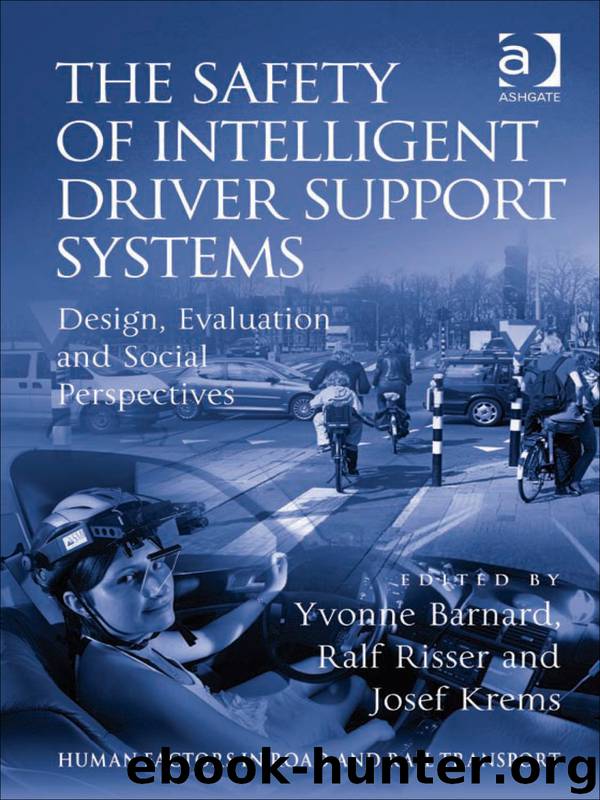The Safety of Intelligent Driver Support Systems by Yvonne Barnard & Ralf Risser & Josef Krems

Author:Yvonne Barnard & Ralf Risser & Josef Krems
Language: eng
Format: epub
Publisher: Ashgate
Published: 2011-03-14T16:00:00+00:00
Simulation
Simulation (representation of vehicle movement through appropriate mathematical formulae) – usually either of driver behaviour or traffic flow models – is a way to evaluate system use, and assess its impact on a larger scale. The aforementioned methods provide results that involve individuals, and not the whole traffic system. These results can be attributed roughly to the whole system under several assumptions. Simulation, however, mainly produces results that involve the whole system. For example, in simulation one can design scenarios that involve a large road network (a city), a great number of system users and/or non-users (system penetration rates) with similar or different characteristics, a great number of scenarios (type of area, type of roads, type of traffic/weather/pavement conditions, etc.), and a long simulation period duration. Simulation models can be classified as microscopic, macroscopic, and mesoscopic, depending on the ‘size’ of the investigated elements. The first involve individuals (drivers or vehicles), the second, flow (with individual elements characteristics not considered), and mesoscopic models form an in-between type of model. The results are usually of a more macroscopic nature than the other evaluation methods produce, even in the case of microscopic models, and especially when using traffic flow rather than driver behaviour models.
A prerequisite for the efficiency of this evaluation method is the performance of other methods (questionnaire, laboratory, driving simulator or instrumented vehicle) prior to it. The validity of the results depends to a large extent on the accuracy of detail in the simulation of system use and impact. There are cases where only system operation is incorporated in the simulation (Liu and Tate 2004); in which cases the effects of the system use on driver behaviour are not considered. However, the results can still provide a rough indication of what to expect in certain scenarios, and under certain conditions.
Simulation methods involve the definition of the appropriate simulation model as well as of the input parameter values. These – depending on the simulation model – mainly involve general simulation parameters (e.g., duration of the simulation), network parameters that describe the road environment (providing the exact network characteristics, including number/position of nodes and links, node and link characteristics such as type of traffic control, traffic signal characteristics, maximum amount of flow, speed limit), driver behaviour characteristics (parameters related to driver perception, speed, acceleration, deceleration, spacing), traffic flow parameters (proportion of different vehicle types, amount of flow, vehicle arrivals), etc.
Simulation results are provided as the output of simulation models, and involve specific parameters that are dependent on the simulation model/software chosen. Examples include traffic flow, mean travel speed, mean travel time, average rate of delay, queue length, headways, time-to-collision, and also environmental, energy, noise or cost indicators, etc.
Download
This site does not store any files on its server. We only index and link to content provided by other sites. Please contact the content providers to delete copyright contents if any and email us, we'll remove relevant links or contents immediately.
Algorithms of the Intelligent Web by Haralambos Marmanis;Dmitry Babenko(8518)
Test-Driven Development with Java by Alan Mellor(7348)
Data Augmentation with Python by Duc Haba(7250)
Principles of Data Fabric by Sonia Mezzetta(6994)
Learn Blender Simulations the Right Way by Stephen Pearson(6929)
Microservices with Spring Boot 3 and Spring Cloud by Magnus Larsson(6761)
RPA Solution Architect's Handbook by Sachin Sahgal(6166)
Hadoop in Practice by Alex Holmes(6028)
Jquery UI in Action : Master the concepts Of Jquery UI: A Step By Step Approach by ANMOL GOYAL(5869)
The Infinite Retina by Robert Scoble Irena Cronin(5868)
Big Data Analysis with Python by Ivan Marin(5692)
Life 3.0: Being Human in the Age of Artificial Intelligence by Tegmark Max(5398)
Pretrain Vision and Large Language Models in Python by Emily Webber(4652)
Infrastructure as Code for Beginners by Russ McKendrick(4436)
WordPress Plugin Development Cookbook by Yannick Lefebvre(4166)
Functional Programming in JavaScript by Mantyla Dan(4121)
The Age of Surveillance Capitalism by Shoshana Zuboff(4111)
Embracing Microservices Design by Ovais Mehboob Ahmed Khan Nabil Siddiqui and Timothy Oleson(3956)
Applied Machine Learning for Healthcare and Life Sciences Using AWS by Ujjwal Ratan(3929)
